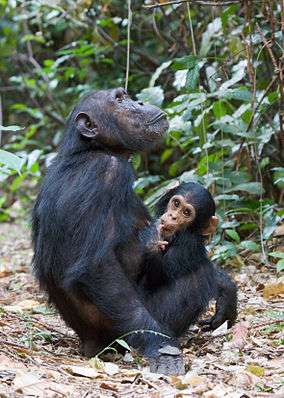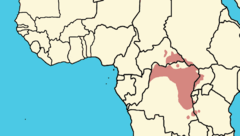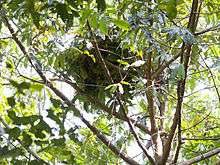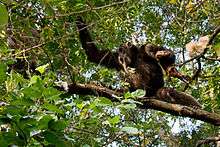Eastern chimpanzee
| Eastern chimpanzee[1] | |
|---|---|
 | |
| Scientific classification | |
| Kingdom: | Animalia |
| Phylum: | Chordata |
| Class: | Mammalia |
| Order: | Primates |
| Family: | Hominidae |
| Genus: | Pan |
| Species: | P. troglodytes |
| Subspecies: | P. t. schweinfurthii |
| Trinomial name | |
| Pan troglodytes schweinfurthii (Giglioli, 1872) | |
 | |
The eastern chimpanzee (Pan troglodytes schweinfurthii) is a subspecies of the common chimpanzee. It occurs in the Central African Republic, the Sudan, the Democratic Republic of the Congo, Uganda, Rwanda, Burundi, and Tanzania.[3]
The 2007 IUCN Red List classified them as Endangered.[2] Although the common chimpanzee is the most abundant and widespread of the non-human great apes, recent declines in East Africa are expected to continue due to hunting and loss of habitat. Because chimpanzees and humans are so physiologically similar, chimpanzees succumb to many diseases that afflict humans.[4] If not properly managed, research and tourism also presents a risk of disease transmission between humans and chimpanzees.
Colin Groves of the Australian National University argues that there is enough variation between the northern and southern populations of P. t. schweinfurthii to be split into two subspecies instead of one; the northern population as P. t. schweinfurthii and the southern population as P. t. marungensis[5]
This subspecies has been extensively studied by Dr. Jane Goodall at Gombe National Park.[4]
Description
Adult chimpanzees in the wild weigh between 40 and 65 kilograms (88 and 143 pounds). Males can measure up to 160 centimetres (63 inches) and females up to 130 centimetres (51 inches) in height. The chimpanzee's body is covered with coarse dark brown hair, except for the face, fingers, toes, palms of the hands and soles of the feet. Both of its thumbs and its big toes are opposable, allowing a precision grip.
Habitat
The chimpanzee will spend time both in trees and on the ground, but will usually sleep in a tree where it will build a nest for the night. They once inhabited most of this region, but their habitat has been dramatically reduced in recent years.
Behavior


Chimpanzees live in communities that typically range from 20 to more than 150 members, but spend most of their time traveling in small parties of just a few individuals. The eastern chimpanzee is both arboreal and terrestrial and spend its nights in the trees, while most of its daytime hours are spent on the ground.[6]
Chimpanzees walk using the soles of their feet and their knuckles, and they can walk upright for short distances. Common chimpanzees are 'knuckle walkers', like gorillas,[6] in contrast to the quadrupedal locomotion (a form of land animal locomotion using four legs) of orangutans and bonobos known as 'palm walkers' who use the outside edge of their palms.
When confronted by a predator, chimpanzees will react with loud screams and use any object they can get against the threat. The leopard is the chimpanzee's main natural predator, but they have also fallen prey to lions.[7]
Diet

Like humans, chimpanzees are omnivorous, meaning their diet consists of plants and animals. Some of the foods a chimpanzee will eat include seeds, fruits, leaves, bark, insects such as termites and small prey. Chimpanzees will often use a twig as a tool to help them reach termites or ants in nests and have been seen using sticks to hunt other small mammals. There are also instances of organized hunting. In some cases, such as the killing of leopard cubs, this primarily seems to be a protective effort, since the leopard is the main natural predator of the common chimpanzee. However, the common chimpanzee sometimes bands together and hunts western red colobus monkeys (Piliocolobus badius) for meat. Isolated cases of cannibalism have also been documented.
See also
| Wikimedia Commons has media related to Pan troglodytes. |
- Bili ape
- Prostitution among animals
- Chimp Haven
- Great ape personhood
- Johann Friedrich Blumenbach Blumenbach and the Chimpanzee
- Theory of mind
- The Third Chimpanzee
General:
- Homininae
- List of apes - list of notable individuals
References
- ↑ Groves, C.P. (2005). Wilson, D.E.; Reeder, D.M., eds. Mammal Species of the World: A Taxonomic and Geographic Reference (3rd ed.). Baltimore: Johns Hopkins University Press. p. 183. OCLC 62265494. ISBN 0-801-88221-4.
- 1 2 Wilson, M.L.; Balmforth, Z.; Cox, D.; Davenport, T.; Hart, J.; Hicks, C.; Hunt, K.D.; Kamenya, S.; Mitani, J.C.; Moore, J.; et al. (2008). "Pan troglodytes ssp. schweinfurthii". IUCN Red List of Threatened Species. Version 2008. International Union for Conservation of Nature. Retrieved 4 January 2009.
- ↑ Hof, Jutta; Sommer, Volker: Apes Like Us: Portraits of a Kinship, Edition Panorama, Mannheim 2010, ISBN 978-3-89823-435-1, p. 114.
- 1 2 Goodall, J. (1996). McGrew, W.C.; Marchant, L. F.; Nishida T., eds. Great Ape Societies. Cambridge: Cambridge University Press. p. xix. ISBN 0-521-55536-1.
- ↑ Groves, CP (2005). "Geographic variation within eastern chimpanzees (Pan troglodytes cf. schweinfurthii Giglioli, 1872)" (PDF). Australasian Primatology.
- 1 2 Janssen, Ellen & Janssen, Paul (2006). "Chimpanzee Fact File". African Wildlife Foundation. Retrieved 23 September 2012.
- ↑ Boesch, Christophe (1991). "The Effects of Leopard Predation on Grouping Patterns in Forest Chimpanzees" (PDF). Behaviour. 1991. 117: 221–242. doi:10.1163/156853991x00544.
External links
- DiscoverChimpanzees.org
- Chimpanzee Genome resources
- Primate Info Net Pan troglodytes Factsheets
- U.S. Fish & Wildlife Service Species Profile
- New Scientist 19 May 2003 - Chimps are human, gene study implies
- Video clips and news from the BBC (BBC Wildlife Finder)

